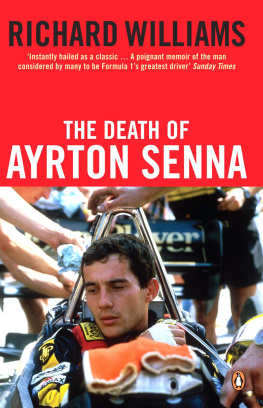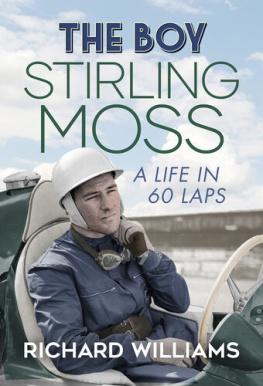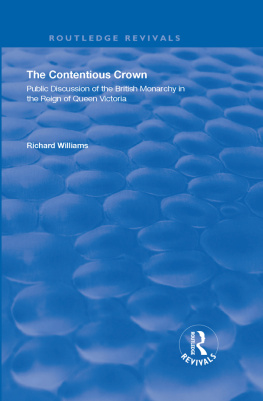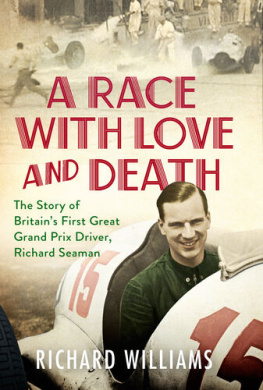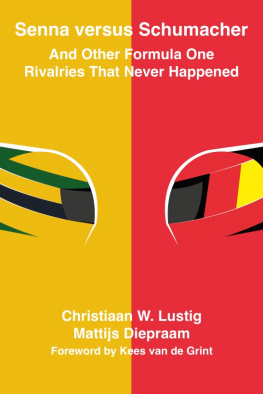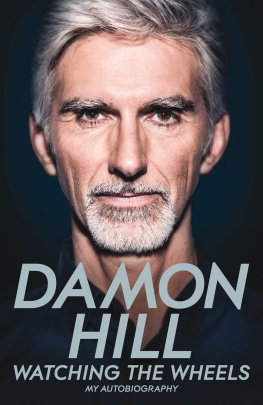Richard Williams - Death of Ayrton Senna
Here you can read online Richard Williams - Death of Ayrton Senna full text of the book (entire story) in english for free. Download pdf and epub, get meaning, cover and reviews about this ebook. year: 2010, publisher: Penguin Books, genre: Detective and thriller. Description of the work, (preface) as well as reviews are available. Best literature library LitArk.com created for fans of good reading and offers a wide selection of genres:
Romance novel
Science fiction
Adventure
Detective
Science
History
Home and family
Prose
Art
Politics
Computer
Non-fiction
Religion
Business
Children
Humor
Choose a favorite category and find really read worthwhile books. Enjoy immersion in the world of imagination, feel the emotions of the characters or learn something new for yourself, make an fascinating discovery.
- Book:Death of Ayrton Senna
- Author:
- Publisher:Penguin Books
- Genre:
- Year:2010
- Rating:5 / 5
- Favourites:Add to favourites
- Your mark:
- 100
- 1
- 2
- 3
- 4
- 5
Death of Ayrton Senna: summary, description and annotation
We offer to read an annotation, description, summary or preface (depends on what the author of the book "Death of Ayrton Senna" wrote himself). If you haven't found the necessary information about the book — write in the comments, we will try to find it.
Death of Ayrton Senna — read online for free the complete book (whole text) full work
Below is the text of the book, divided by pages. System saving the place of the last page read, allows you to conveniently read the book "Death of Ayrton Senna" online for free, without having to search again every time where you left off. Put a bookmark, and you can go to the page where you finished reading at any time.
Font size:
Interval:
Bookmark:
I have cause to be grateful for the wisdom of many authors and journalists in the field of motor sport; particular debts are owed to the late Denis Jenkinson, the late Henry N. Manney III and Nigel Roebuck. In the press rooms of the modern grands prix, it is always a pleasure to hear the latest news from such erudite and generous spirits as David Tremayne, Maurice Hamilton, Alan Henry, Derick Allsop, Oliver Holt and Tim Collings. Back at the office, conversations with my friend Stephen Wood helped clarify the arguments, as well as diverting us both from the duties of the day.
Alert readers will have noticed that this is by no means the only book on the subject of Ayrton Senna. Others include Ayrton Senna: The Hard Edge of Genius by Christopher Hilton (Patrick Stephens, 1990; Corgi, 1991), and the same authors posthumous Ayrton Senna (Patrick Stephens, 1994); Remembering Ayrton Senna by Alan Henry (Weidenfeld and Nicolson, 1994); Ayrton Senna: A Personal Tribute by the photographer Keith Sutton (Osprey, 1994); Ayrton Senna do Brasil by Francisco Santos (Edipromo, So Paulo, 1994); Goodbye Champion, Farewell Friend by Karin Sturm (MRP, 1994); Ayrton Senna: A Tribute by Ivan Rendall (Pavilion, 1994); My Life With Ayrton by Adriane Galisteu (APA, 1994); and Ayrton Senna:Prince of Formula One by Ken Ryan (APA, 1994).
The passage in which Senna describes his mystical experience at Monaco in 1988 comes from Grand Prix People by Gerald Donaldson (MRP, 1990). Steve Lacys description of the parallel experience of the musician can be found in Improvising: Its Nature and Practice in Music by Derek Bailey (The British Library, 1992). Enzo Ferraris views on Fangio are from Le mie gioie terribili (Licinio Capelli, Bologna, 1963) and Gino Rancatis Ferrari, lui (Sonzogno, Turin, 1977). Fangios views on Ferrari are from Ma vie 300 lheure (Plon, Paris, 1961) and Fangio: My Racing Life (Patrick Stephens, 1990). Phil Hills memory of passing a team mates accident is from The Cruel Sport by Robert Daley(Studio Vista, 1963).
Andrew Longmores reconstruction of Sennas last twenty-four hours in The Times was informative, as were the relevant passages from Denis Jenkinsons The Racing Driver (Batsford, 1958) and A Story of Formula 1 (Grenville, 1960), The Great Racing Drivers , edited by David Hodges (Temple Press, 1966), David Tremaynes Racers Apart (MRP, 1991), Inside Formula 1 , a collection of Nigel Roebucks columns (Patrick Stephens, 1989), Timothy Collingss Schumacher (Bloomsbury, 1994), and Damon Hills Grand Prix Year (Macmillan, 1994). Also in The Times , Simon Barnes has written perceptively about Sennas character.
Newspapers and periodicals consulted include Autosport, Motor Sport and Motoring News (UK), LEquipe (France), La Gazzetta dello Sport, Auto + Sport and Autosprint (Italy), and A Gazeta Esportiva , O Estado de S o Paulo and Isto (Brazil). Special thanks go to Pino Allievi and Giancarlo Galavotti of the Gazzetta and Paolo Ciccarone of Auto + Sport .
I am particularly indebted to Ian Jack, editor of the Independent on Sunday , where some of these passages took their initial form as real-time journalism; to Simon OHagan, my first sports editor at the paper; to Alan Rusbridger, editor of the Guardian , and to his sports editor, Mike Averis; and to Simon Kelner, who put me on the flight to So Paulo, where Ana Ceclia Americano taught me the meaning of saudade .
ABOUT THE AUTHOR
Richard Williams is chief sports writer for the Guardian . His previous jobs include chief sports writer of the Independent , assistant editor of The Times , editor of Time Out and Melody Maker , and head of artists and repertoire at Island Records. His most recent book is The Blue Moment: Miles Daviss Kind of Blue and the Remaking of Modern Music .
The first flush of daylight was lining the eastern sky as Flight RG723 said goodbye to its fighter escort and swung into the landing pattern, bringing him home for the last time. Already his people were gathering along the expressway from the airport through the suburbs, a million of them or more, carrying their flags and banners, preparing their tears of welcome and lamentation as the big jet came out of the rising sun into So Paulo.
Eleven hours out of Paris, Captain Gomes Pinto floated the McDonnell-Douglas M D11 and its strange cargo over the endless clusters of high-rise blocks with their shanty-town infills. So Paulo may be one of the biggest and ugliest cities on earth, a vast megalopolis of extreme wealth and extreme poverty, but in that dawn its inhabitants turned into villagers, sharing in the mourning for their golden boy, their favourite son, their champion.
At 6.12 a.m. the plane touched down on the main runway of Guaralhos airport. Its passengers, restricted to the economy compartment, disembarked. Over the next thirty minutes the polished mahogany casket containing the mortal remains of Ayrton Senna was removed from the business-class section, lowered to the ground on an electric lift, and carried by soldiers of the Polcia da Aeronutica to a waiting fire-engine, where it was draped with the bandeira , the familiar green and yellow national flag of Brazil. At 6.45 a.m. under a sky already bright blue, the fire-engine moved off, preceded by an arrowhead of seventeen police outriders in white leathers who led the motorcade on the thirty-kilometre journey into the city.
Just beyond the airport perimeter, the taxi driver found a gap to park on the already crowded grass verge. We jumped out and ran up the slope to join the people lining the six-lane highway, just in time to see the parade go by. On the rear deck of the fire-engine, a quartet of white-capped cadets from the Military Police school sat on either side of the coffin, facing fore and aft, mounting guard; five more clung to the ledge at the rear of the vehicle. Behind it, in the slipstream of the spectators applause, came the official cars and the police vans. As soon as they had passed, the taxi driver and I slid back down the steep grass slope, got back into the car, and immediately found ourselves sucked into the wedge of unofficial traffic following the motorcade.
It was a vast dusty mass numbering hundreds of vehicles in all shapes and sizes and states of repair, battered Beetles and shiny Subarus, smart new XR3s and heavily oversubscribed jeeps, taxis and pick-ups, a Mack truck flying a Brazilian flag the size of a house, all crossing and recrossing the central reservation, some racing headlong down the wrong side of the carriageway in an attempt to keep up with Ayrton Sennas last ride. Most of the cars had his photograph taped inside the windscreen, or black scarves tied to the radio aerial. One car-borne banner, hastily hand-lettered, read Adeus Ayrton Tricampeo . Farewell, Ayrton triple champion. From many side-windows, in an echo of Sennas trademark gesture on so many afternoons of triumph around the world, a spare hand held a bandeira , its colours stiffened in the airstream.
Witnesses to this spectacle, this Mad Max remake of a grand prix lap of honour, the people of Ayrton Sennas home town thronged the pavements and overpasses and windows and parapets of their crumbling concrete canyons, applauding the passage of their champion and shedding neither the first nor the last of their tears. Motorcycles and pushbikes joined the parade. As the days rush hour began, the weight of extra traffic choked the city. Sometimes, like the people in the blocked-off side roads, we had to stop and switch off the engine, getting out and turning our faces to the sky, where a dozen police and television helicopters hovered and circled, marking the motorcades progress like a cloud of mid summer midges.
As we passed through the Anhangabau tunnel, a group of bikers set up a chant: Ol, ol, ol, ol, Senna. Now banners and freshly sprayed graffiti were everywhere, dangled from every bridge, painted on every blank surface: Obrigado Senna (thank you, Senna), Senna no morreu, porque os deuses no morrem (Senna isnt dead, because gods dont die). And Obrigado, Senna por fazer nossos domingos felizes (thank you, Senna, for making our Sundays so happy).
Font size:
Interval:
Bookmark:
Similar books «Death of Ayrton Senna»
Look at similar books to Death of Ayrton Senna. We have selected literature similar in name and meaning in the hope of providing readers with more options to find new, interesting, not yet read works.
Discussion, reviews of the book Death of Ayrton Senna and just readers' own opinions. Leave your comments, write what you think about the work, its meaning or the main characters. Specify what exactly you liked and what you didn't like, and why you think so.

